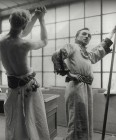
Studio, Models and Staged Photography (25 works)
Mucha began to take photographs in the early 1880s, probably in Vienna, with a borrowed camera. It was not until he had gained some recognition in Paris and sufficient funds that he purchased his first camera. Mucha’s photographic output grew dramatically after his move to a large studio in the rue du Val de Grâce in 1896. In the new studio, where he had considerably more light thanks to large windows and a glass ceiling, he photographed on a virtually daily basis.
Between 1896 and the early 1900s Mucha made a remarkable series of photographs of the models posing for him. The use of photography as an inexpensive medium for preliminary studies was common among Mucha’s Parisian contemporaries. However, Mucha’s photographs are more than just an alternative to sketches because they also capture the inimitable atmosphere of Mucha’s studio – a world of art in its own right. It was in his studio that that Mucha entertained countless Parisian artists, writers and musicians. It was also the setting for one of the earliest cinematic projections given by the Lumière brothers, whom Mucha had met in 1895, and for psychic experiments with Camille Flammarion and Albert de Rochas. In the background of the studies of models, examples of Mucha’s work may be seen, surrounded by his collection of objets d’art, books and furniture, many of which survive to this day.
The majority of Mucha’s Parisian photographs were not taken for a specific project – he preferred to improvise a number of poses in front of the camera, creating an archive of variants from which he could select what he considered most suitable for the subject of each new commission. However, some photographs were obviously directed, with his friends and models posing as characters for book illustration. Later this practice grew into a part of his experimentation with his models to express his philosophical ideas through theatrical poses and gestures.
Mucha’s theatrical approach culminated in his preparatory work for the Slav Epic canvases. Before working on each canvas Mucha produced numerous staged photographs documenting costumed models posing under his ‘theatre’ directions. From these photographs he selected appropriate images and synthesised them to create a complicated historical event on a single canvas. Although the images were intended as studies for his final paintings, Mucha’s approach to image-making has much in common with filmmaking.

